Preliminary results from the Statistical Institute of Belize’s April 2019 Labour Force Survey show that the unemployment rate in the country decreased from 9.4 percent in April 2018 to 7.6 percent a year later. This has been the lowest rate ever recorded and resulted from a net increase of 8,478 in the number of persons with jobs coupled with a number of persons exiting the labour force. Overall, the Belize District experienced the highest gains in employment, while the Cayo District saw persons – most of whom were females – leaving the labour force, resulting in a fall in the national unemployment rate.
Labour Force: Approximately 177,915 persons were estimated to be in the labour force in April 2019 (See Figure 1). A net increase of 5,829 persons was observed, of which 73 percent or about 4,231 were males. This was in contrast to what was seen last year, when there was a large influx of women into the labour force. Notwithstanding this increase in the number of persons in the labour force, the Cayo district registered a net decline of 1,300 persons.
About two-thirds of the working age population were a part of the labor force, either holding jobs or available for employment. However, women remained far less likely to be a part of the labour force, with a participation rate of 53 percent, compared to almost 80 percent among males. For both males and females, participation was highest in persons aged 35 to 44 years, and lowest in the 14 to 24 years age group.
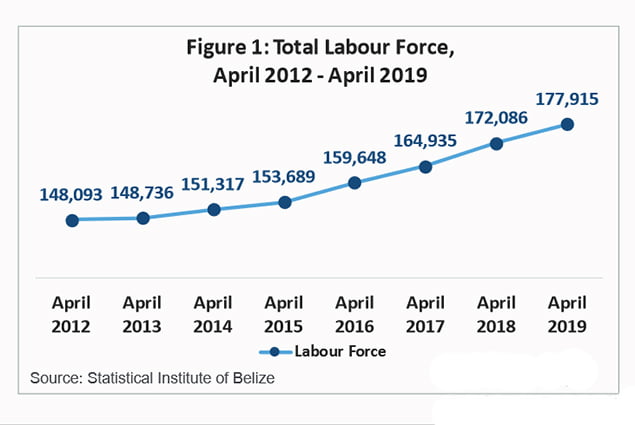
Employed: The number of employed persons as of April 2019 was estimated at 164,428, an increase of 8,478 from April 2018. Males and females contributed roughly the same numbers to this growth in employment, with 4,380 of new jobs going to males and 4,098 being taken up by females. Persons aged 25 to 34 years accounted for the largest group of employed persons, representing 28.2 percent of all persons with jobs.
About 26 percent of all employed persons held jobs that were classified as ‘Services and Sales Workers’, followed by 22.7 percent who worked in ‘Elementary Occupations’ (see Figure 2). In general, men were seen to be more actively employed in the latter category, with almost a quarter of males holding jobs classified as ‘Elementary Occupations’, while more than 37 percent of females were employed as ‘Services and Sales Workers’. Across the districts, Belize registered the largest gains in employment, largely due to over 4,300 more jobs in ‘Services and Sales’.
Among the industries, the three biggest employers were ‘Agriculture and Related Activities’, ‘Wholesale and Retail Trade and Repairs’, and ‘Tourism’. These three categories combined accounted for almost a half of all jobs in the country, with each providing jobs to just under 16 percent of the employed labour force.
The national median monthly income in April 2019 was $1,244, a small increase of $26 from April 2018. Men continued to earn slightly more than women, with a median monthly income of $1,268 compared to $1,207 for females. A more significant gap was observed between urban and rural workers, as the median monthly income for urban persons stood at $1,409 compared to $1,101 for rural workers.
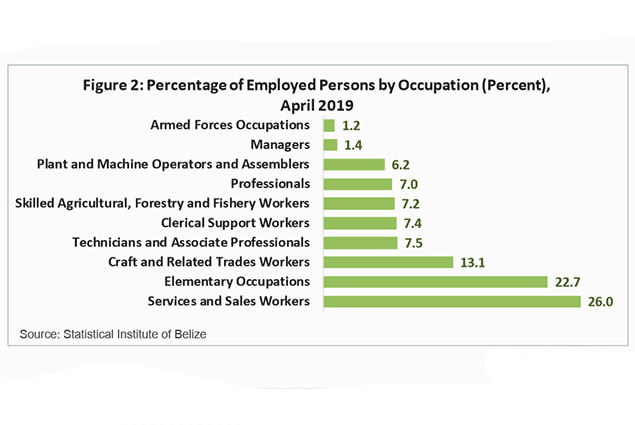
Unemployment: Overall, the level of joblessness in the country went down by 1.8 percentage points in the twelve months since April 2018 (see Figure 3). While unemployment among females decreased by almost 4 percentage points from 14.9 percent to 11 percent between April 2018 and April 2019, females continued to be twice as likely to be unemployed as males. The unemployment level among males also fell, although at a much smaller margin, from 5.6 percent in April 2018 to 5.3 percent in April 2019.
For the month of April 2019, the unemployed population was estimated at 13,486 persons, a decrease of about 2,650 persons from April 2018. Across the districts, except for Corozal and Orange Walk, unemployment rates were down, with the largest decline being observed in the Cayo District, where the rate of joblessness fell from 13.6 percent in April 2018 to 9.8 percent in April 2019. This fall was attributed primarily to almost 1,300 persons dropping out of the labour force. Nonetheless, despite having the largest drop in the level of unemployment, particularly in rural areas, this district still registered the highest unemployment rate in April 2019 (see Figure 1). The Belize District also experienced a decline in the level of unemployment, from 8.5 percent to 6.8 percent, over the year. However, unlike Cayo, this district saw a net increase of about 7,200 employed persons, resulting in depressed unemployment rates for the period. Stann Creek District also had a net increase of about 1,138 employed persons, further contributing to the decrease in national unemployment. Overall, unemployment levels in urban areas were slightly higher when compared to rural areas.
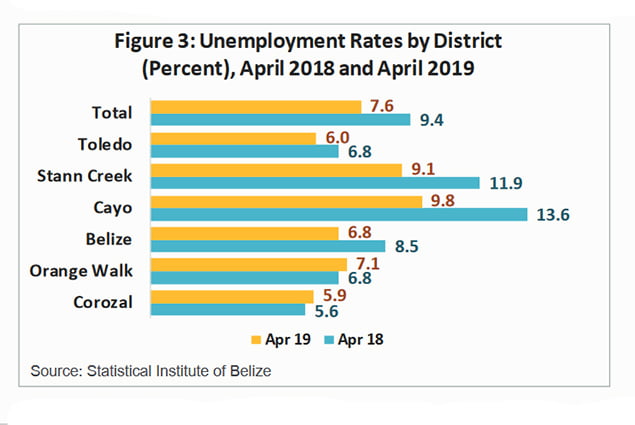
Underemployed: In April 2019, an estimated 25,248 persons were underemployed, holding jobs but working less than 35 hours per week. This total represented about 15.4 percent of all employed persons and is about twice as many as the number of unemployed. Between the sexes, women continue to be significantly more likely to be underemployed compared to their male counterparts. Of the 100,822 males with jobs, 11,227 or 11.1 percent were underemployed, while of the 63,607 females that were employed, 14,021 or 22 percent fell into the underemployed category.
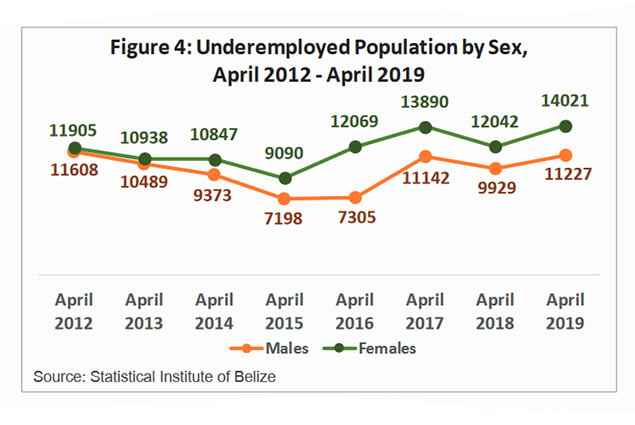
Persons not in the Labour Force: Persons Not in the Labour Force (PNLF), those who were not working and were not available for work, made up about 33.8 percent (90,948 persons) of working age persons in Belize as of April 2019. This was a marginal net growth of 504 persons from April 2018 to April 2019, as 1,563 females joined this group while 1,058 males moved from this group into the labour force. Cayo District saw the greatest increase in PNLF, with the number of persons not participating in the labour force rising by 2,959 persons, while the Belize District saw its PNLF drop by 4,373 persons.
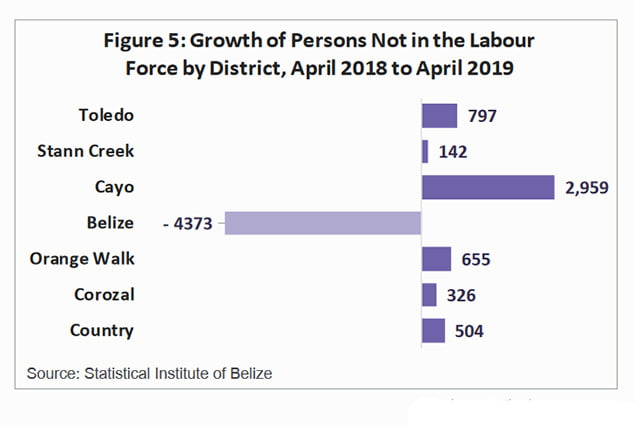
For more information contact data dissemination department at telephone number 822-2207/2352 or e-mail at info@mail.sib.org.bz












